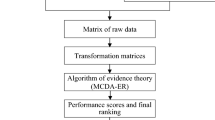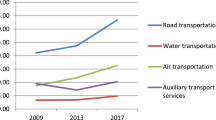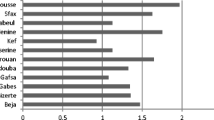Abstract
The purpose of this paper is to assess the cost-structure of the public transport industry in Tunisia. Thus, we use a translog variable cost function to identify the firms’ technological features. In this analysis, we work on a sample of 12 Tunisian regional transport companies (RTC) over the 2000/2010 period. The main results show the critical productive situation of the urban public transport system in Tunisia. This can be exemplified by the presence of a short and long term diseconomy of scale, given that the overall factor productivity is low and almost zero.
Similar content being viewed by others
Notes
Equalization payments: they are cash payments made with the objective of reducing both wealth disparities and inequality, but at the expense of transparency in real costs, which can bias the decisions. Equalization is a rule of public service management. In fact, it is a system of resource redistribution among several administrative units. For example, the State sets up an equalization program in the operating subsidies awarded to counties so that the smallest of them can benefit from an acceptable budget.
ES = 1: elasticity is equal to 1, therefore, the economies of scale are constant.
ES < 1: elasticity is greater than 1, there are diseconomies.
ES > 1: elasticity is less than 1, there are economies of scale.
The capital is owned by the organizing authority and represents the number of buses at the park, on 31/12 every year. Each company thus minimizes the costs of a subset of production factors, conditionally at the level of the capital provided by the authority. The capital may then be considered as a quasi-fixed production factor and the cost function is therefore no longer considered as a total cost function but rather a variable cost function. Such an approach makes us consider that the urban transport industry in all the periods is unbalanced compared to the available capacity provided by the organizing authority (Gagnepain 1998).
According to Fraquelli et al. 2001, the parameter estimates are invariant to the choice of which equation is deleted as long as the Iterated SUR (or Maximum Likelihood) estimation method is employed on the M − 1 factor-share equations.
Beja, Bizerte, Gabes, Gafsa, Jendouba, Kairouan, Kasserine, Kef, Mednine, Nabeul, Sfax and Sousse.
Throughout this article the abbreviation Y SK is used, which denotes number of seats per kilometre.
See Appendix.
The model is estimated by the STATA 11.2 econometric software, with the command "SUREG".
Breusch-Pagan test of independence: Chi2(3) = 126.672(P value = 0.000, i.e. <1 %).
Since the variables costs and all the continuous explanatory variables are in logarithms, the estimated first order coefficients can be interpreted as cost elasticities.
See Blackorby and Russell (1989).
A Cobb-Douglas would not be appropriate because the elasticity of substitution is imposed to be equal to unity for all factors of production.
We are facing a natural monopoly, in which the price is higher than marginal cost (P > mc), which causes a loss of well-being (a Malthusian behavior). For this, the Ministry of Transportation (The organizing authority of the natural monopoly) prohibits investors to enter the public transport market by building strategic barriers in order to make the most loyal customers.
Bus rapid transit: the system of rapid and inexpensive buses compared to the subway is very successful in both the developing and in the industrialized countries. Operating on dedicated traffic lanes, the BRT system greatly increases the average speed of the public transport network. Moreover, it fits into a broader mobility management and seeks an interaction with the urban planning. For detail see, e.g., Levinson et al. (2003); Hensher and Golob (2008); Widanapathiranage et al. (2015).
A Cobb-Douglas function may not be appropriate because the substitution elasticity must be equal to the unity for all the production factors.
Abbreviations
- P :
-
Price of inputs
- VC :
-
The variable cost
- Y :
-
Production vector
- x :
-
Vector of the used inputs
- β :
-
Coefficient
- K :
-
Quasi-fixed capital
- L :
-
Labor
- E :
-
Energy
- MS :
-
Materials and services
- Z :
-
The length of network
- Trend :
-
Technical progress (time indicator)
- S i :
-
Share factor of input i
- RMSE :
-
The root-mean-square error i.e. the square root of the variance, known as the standard deviation
- R-sq :
-
R-squared
- Chi 2 :
-
Chi-squared test
- P value :
-
P value is automatically determined by STATA. The latter takes into account the number of degrees of freedom and tells us at what level our coefficient is significant
- SE :
-
Standard error
- ES SR--ES LR :
-
Short and long-run economies of scale
- ED SR -ED LR :
-
Short and long-run economies of density
- σ A ii :
-
Own-price elasticity of Allen
- σ A ij :
-
Cross-price elasticity of Allen
- M :
-
Morishima’s elasticity of substitution
- PGY :
-
Overall productivity production (Y = YSK)
- PGX :
-
Overall productivity of factors (X)
References
Abbes S, Bulteau J (2001) Analyse des caractéristiques des réseaux de transport collectif urbain en France. University of Calgary
Barros CP (2006) A benchmark analysis of Italian Seaport using data envelopment analysis. Marit Econ Log 8:347–365
Berndt ER, Wood DO (1975) Technology, prices, and the derived demand for energy. Rev Econ Stat 57:259–268
Bhattacharyya A, Kumbhakar SC, Bhattacharyya A (1995) Ownership structure and cost efficiency: a study of publicly owned passenger-bus transportation companies in India. J Prod Anal 6:47–61
Blackorby C, Russell RR (1989) Will the real elasticity of substitution please stand up? (A comparison of the Allen/Uzawa and Morishima elasticities). Am Econ Rev 79:882–888
Boitani A, Nicolini M, Scarpa C (2013) Do competition and ownership matter? Evidence from local public transport in Europe. Appl Econ 45(11):1419–1434
Button K, O’donnell KH (1985) An examination of the cost structures associated with providing Urban bus services. Scott J Polit Econ 32:67–81
Buzzo Margari B, Erbetta F, Petraglia C, Piacenza M (2007) Regulatory and environmental effects on public transit efficiency: a mixed DEA-SFA approach. J Regul Econ 32(2):131–151
Cambini C, Piacenza M, Vannoni D (2007) Restructuring public transit systems: evidence on cost properties from medium and large-sized companies. Rev Ind Organ 31(3):183–203
Caves DW, Christensen LR, Tretheway MW (1984) Economies of density versus economies of scale: why trunk and local service airline costs differ. Rand J Econ 15:471–489
Christensen LR, Jorgenson DW, Lau LJ (1973) Transcendental logarithmic production frontiers. Rev Econ Stat 55(1):28–45
Dalen DM, Gomez-Lobo A (2003) Yardsticks on the road: regulatory contracts and cost efficiency in the Norwegian bus industry. Transportation 30:371–386
De Borger L (1984) Cost and productivity in regional bus transportation: the Belgian case. J Ind Econ 33(1):37–54
Filippini M, Maggi R, Prioni P (1992) Inefficiency in a regulated industry: the case of the Swiss regional bus companies. Ann Public Coop Econ 63:437–455
Fraquelli G, Piacenza M, Abrate G (2001) Il trasporto pubblico locale in Italia: variabili esplicative dei divari di costo tra le imprese. Econ Polit Ind 111:51–81
Fraquelli G, Piacenza M, Abrate G (2004) Regulating public transit networks: how do urban-intercity diversification and speed-up measures affect firms’ cost performance? Ann Public Coop Econ 75(2):193–225
Gagnepain P (1998) Structures productives de l’industrie du transport urbain et effets des schémas réglementaires. Econ Prév 135(4):95–107
Greer M (2006) Are the discount carriers actually more efficient than the legacy carriers?: a data envelopment analysis. Int J Transp Econ 33:37–55
Hensher DA, Golob TF (2008) Bus rapid transit systems—a comparative assessment. Transportation 35(4):501–518
Hilmola OP (2007) European railway freight transportation and adaptation to demand decline: efficiency and partial productivity analysis from period of 1980–2003. Int J Prod Perform Manag 56(3):205–225
Jha R, Singh SK (2001) Small is efficient: a frontier approach to cost inefficiencies in Indian state road transport undertakings. Int J Transp Econ 28(1):95–114
Karlaftis MG (2010) Ownership and competition in European transit: assessing efficiency. Transportmetrica 6(2):143–160
Karlaftis MG, McCarthy P (2002) Cost structures of public transit systems: a panel data analysis. Transp Res Part E 38:1–18
Kennedy P (1985) A guide to econometrics, 2nd edn. The MIT Press, Cambridge
Levaggi R (1994) Parametric and non parametric approach to efficiency: the case of urban transport in Italy. Stud Econ 49(53):67–88
Levinson H, Zimmerman S, Clinger J, Rutherford S, Smith RL, Cracknell J, Soberman R (2003) Bus rapid transit, volume 1: case studies in bus rapid transit. Transit Cooperative Research Program (TCRP) Report 90. Transportation Research Board, Washington
Lin LC, Tseng CC (2007) Operational performance evaluation of major container ports in the Asia–Pacific region. Marit Policy Manag 34(6):535–551
Lozano S (2009) Estimating productivity growth of Spanish ports using a non-radial, non oriented Malmquist index. Int J Shipp Transp Log 1(3):227–248
Martín JC, Reggiani A (2007) Recent methodological developments to measure spatial interaction: synthetic accessibility indices applied to high-speed train investments. Transp Rev 27(5):551–571
Matas A, Raymond JL (1998) Technical characteristics and efficiency of urban bus companies: the case of Spain. Transportation 25:243–263
Mikerbi SM, Dridi HS (2007) Efficience technique dans le transport urbain en Tunisie: Une approche paramétrique. Département de sciences économiques, Université de Sfax, MODEVI, FSEG-S, Tunisie
Obeng K (1985) Bus transit cost, productivity and factor substitution. J Transp Econ Policy 19(2):183–203
Ottoz E, Fornengo G, Di Giacomo M (2009) The impact of ownership on the cost of bus service provision: an example from Italy. Appl Econ 41(3):337–349
Panzar JC, Willing RD (1977) Economies of Scale in Multioutput production. Quart J Econ 91:481–493
Piacenza M (2006) Regulatory contracts and cost efficiency: stochastic frontier evidence from the Italian local public transport. J Prod Anal 25(3):257–277
Scheraga C (2004) Operational efficiency vs. financial mobility in the global airline industry: a data envelopment analysis and Tobit analysis. Transp ResA 38:383–404
Shaw-Er J, Chiang W, Chen YW (2005) Cost structure and technological change of local public transport: the Kaohsiung City Bus case. Appl Econ 37(12):1399–1410
Shephard RW (1953) Cost and production functions. Princeton University Press, Princeton
Shephard RW (1970) Theory of cost and production functions. Princeton University Press, Princeton
Thiry B, Lawaree J (1987) Productivité, coût et caractéristiques technologiques des societés belges de transport urbain. Annales de l’économie publique, sociale et coopérative 4:369–396
Uzawa H (1962) Production functions with constant elasticities of substitution. Rev Econ Stud 29:291–299
Viton P (1981) A Translog cost function for urban bus transit. J Ind Econ XXIX:287–304
Widanapathiranage R, Bunker JM, Bhaskar A (2015) Modelling the BRT station capacity and queuing for all stopping busway operation. Public Transp 7(1):21–38
Williams M, Dalal A (1981) Estimation of the elasticities of substitution in urban bus transportation: a cost function approach. J Reg Sci 2:263–277
Zellner A (1962) An efficient method of estimating seemingly unrelated regressions (SUR) and tests for aggregation bias. J Am Stat Assoc 57:348–368
Author information
Authors and Affiliations
Corresponding author
Appendix
Appendix
Choosing the most efficient output for our study is made by carrying out a correlation test between three types of output measures and the variable cost.
As shown in Table 14, most of the correlation coefficients are below 0.8, which corresponds to the limit set by Kennedy (1985) from which we usually start to have serious problems of multi-collinearity. Nevertheless, this does not prevent us from finding a strong correlation between outputs “Traveled kilometres”, “Passenger per kilometres” and the dependent variable “VC” therefore exceeding the threshold of 0.8. This raises a problem of multi-collinearity between the output and the dependent variable. For this reason, we opt for the supply measure represented by the variable SK to identify our output.
Rights and permissions
About this article
Cite this article
Ayadi, A., Hammami, S. Analysis of the technological features of regional public transport companies: the Tunisian case. Public Transp 7, 429–455 (2015). https://doi.org/10.1007/s12469-015-0109-4
Published:
Issue Date:
DOI: https://doi.org/10.1007/s12469-015-0109-4




